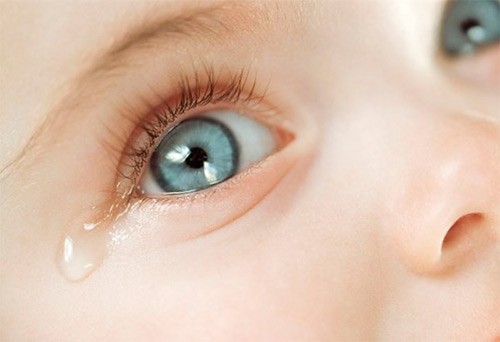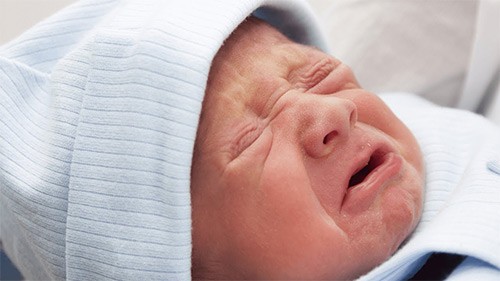Most babies, having passed the necessary cycle of intrauterine development, are born, not yet able to know a number of things – for example, cry with tears. This function was not needed before, the amniotic fluid did an excellent job with the function of moisturizing and cleansing the eye.
Many organs of the child during the first years of life are forced to undergo a process of development and improvement – the eyes of the baby will learn to focus on the subject and examine the world around them in color.
A person perceives most of the information about the world with his eyes; for their normal functioning, the correct operation of the lacrimal canal is necessary.
Crying without tears
Young parents are often interested in why newborns cry without tears and at what age they should appear. The cause of the phenomenon is in the features of the development of the baby’s organs of vision.
After birth, the body of the newborn is covered with a thin coating. This grease protects the baby from bacterial attack and minor damage. But there is not only plaque on the skin, it is present on the conjunctiva of the eyes of the baby and the jelly-like plug closes the lacrimal canal. During the development of the embryo, this plug closes the lacrimal canal, protecting it from the penetration of amniotic fluid.

In order for it to open, time is needed – usually tearing should begin up to 45 days, although there are unique ones that can shed tears from the moment of birth.
The main reasons for the later opening of the lacrimal ducts:
- immaturity, it takes time to start functioning, for each baby an individual period will be required;
- the ducts have a developmental feature – they are too narrow;
- the plug blocking the duct is too thick;
- congenital weak channel functionality;
- congenital pathology;
- acquired inflammatory eye disease.
The development of each baby is individual, and each at different times will open the lacrimal canal and the lacrimal glands will begin to function. Until this time, the child cries without tears.
Eye care
After birth, the baby is in an unusual air environment, most of the time he sleeps. During wakefulness, the baby’s eyes are dry – the eyes are not hydrated enough. The kid needs extra eye care for greater comfort. Sometimes the need for such care is indicated by redness of the eyes and eyelids, purulent discharge may appear in the corners of the eyes. This phenomenon does not go away on its own, so parents should cleanse the baby’s eyes in the morning.

When washing a baby with a clean cotton pad moistened with warm water, you need to thoroughly, but carefully, rinse your eyes moving from ear to nose, for each eye use a separate disk. This procedure is carried out in the evening with daily bathing. Traditional medicine recommends using breast milk for this procedure.
If symptoms of redness or suppuration of the eyes are noted, the child should be shown to the doctor. Rinsing with a pink solution of potassium permanganate (the solution should be very weak) or infusion of chamomile pharmacy helps well. Potassium permanganate must be diluted, carefully making sure that all the grains of the substance are dissolved.
To prepare a decoction of chamomile, it is worth using a pre-packaged chamomile, which is steamed in a cup. For one bag you need 100 grams of hot water. For washing, the infusion needs to be cooled to room temperature.
If there is a pharmaceutical herb, then for brewing take a teaspoon of grass per 100 grams of boiling water. After the infusion has cooled slightly, it should be drained through several layers of gauze and used for washing.
First tears
The lacrimal glands begin to work in the baby after 45-60 days from the moment of his birth, until this time the newborn cries without tears. After their appearance, the cork sealing the lacrimal duct begins to dissolve more actively. Until the full restoration of the free flow of fluid through the ducts, moisture will not be freely released.
According to Dr. Komarovsky, with normally developed channels, tears flow into the nasopharynx, the process is painless, children and mothers do not notice how moisture occurs and flows.
Such babies will be able to cry normally by the age of three months. When tears appear in a crying baby, they go in different ways – for someone as large as peas, for someone it will be small single droplets.
If there is no free outflow, then accumulating in the ducts, tears in the newborn will provoke irritation of the nasal mucosa, causing inexplicable snot. Stagnant moisture and a runny nose makes the child moody, the whites of the eyes can turn red, when pressed on the nose and forehead, the child will bend and cry.
If a similar situation persists, the child should be shown to the doctor. The diagnosis will be obstruction of the nasolacrimal ducts, the baby needs help to correct the situation.
Doctor’s help
After the child turns one month old, the baby needs to be shown to the doctor. Such scheduled examinations must be carried out after the child reaches the age of three months, six months and a year.
The purpose of inspection by a specialist:
- baby eye condition;
- determination of the correct structure of the eye;
- determination of the approximate opening date of the nasolacrimal canal;
- eyesight check;
- providing advice to parents on the care of the child’s eyes;
- the appointment of necessary therapeutic measures.
At the age of six months, the doctor will be interested in the coordination of visual and grasping reflexes, the child’s ability to clearly perceive objects and his visual acuity. By this age, the lacrimal canal should work fine, the baby is able to cry with a lot of tears.
To determine the quality of the functioning of the lacrimal duct, the optometrist performs a special color test. For this:
- A colored solution is instilled into the baby’s eyes (this may be a yellow solution of furatsilina);
- Cotton swabs are inserted into the nostrils;
- After 10 minutes, the amount of colored fluid in the eyes and the appearance of paint on the swabs are evaluated.
If staining does not occur, obstruction of the nasolacrimal canal is determined.
To restore patency of the nasolacrimal canals, the doctor may prescribe a massage for the child. His mother performs the baby at home alone.
If the doctor decides on the need to restore duct obstruction, the ophthalmologist performs a small intervention with local anesthesia.
The child is instilled with eyes with a special composition, then a probe is used to expand the lacrimal canal. After the procedure, it is cleaned of the cork and becomes free for the outflow of moisture, a tear appears in the eyes of the baby.
Tear duct massage
In some cases, only one channel becomes passable, a sign is a tear that flows from only one eye. The diagnosis in this case is infant dacryocystitis.
Parents should pay attention – a runny nose with dacryocystitis is not associated with salivation, as it will be with a cold, when the eyes turn sour, slobber runs and a runny nose appears.
The reason is a violation in the opening of the lacrimal canal or the appearance in it of cords (adhesions) that impede the outflow of tears. The fluid accumulating in the lacrimal sac causes discomfort, with the onset of infection, pus appears. Sometimes antibiotics are prescribed in such cases, but the most effective treatment is massage, which will restore the outflow and relieve inflammation.
Massage helps to open the second duct, push out the cork that stood in it. For massage, you must:
- wash hands thoroughly with odorless soap and warm water;
- make a clean cotton pad;
- gently press with your fingertips on the skin under the eye tubercle;
- massage is carried out first under one, then under the second eye for one to two minutes;
- Carefully remove the contents of the lacrimal canal with a cotton pad.
Massage is carried out 5-6 times a day for a minute. The procedure is painless, if properly performed, the child should not cry. The opening of the canal and the exit of the birth plug occurs 2-3 days after the start of the massage.
Additionally, the child should be washed with chamomile, potassium permanganate, and a solution of furatsilin. What kind of solution to use and what its concentration should tell the doctor! After tears appeared in the second eye, you need to show the child again to the doctor to make sure that the disease has passed.
Parents should carefully monitor the baby and immediately consult a doctor if tears are delayed – visual acuity and the development of the baby in the future depend on this.



